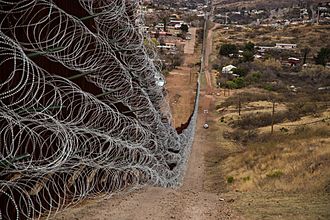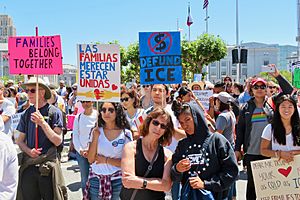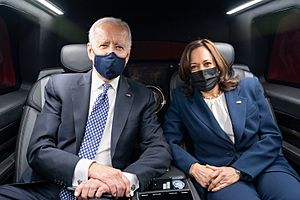Mexico–United States border crisis facts for kids

Border between Nogales, Arizona and Nogales, Sonora
|
|
| Motive | Illegal immigration to and asylum seeking in the US |
|---|---|
| Target | Migrants from Central America |
| Deaths | 7,216 (1998–2017) At least 853 in 2022 |
| Arrests | 2.3 million in 2022 |
The Mexico–United States border crisis is an ongoing situation where many people from Latin America travel through Mexico to reach the United States. These people are often seeking a safer or better life.
This movement of people has been happening for a long time. However, the number of people trying to cross the Mexico-U.S. border started to increase a lot in late 2020. In 2021, about 1.73 million people were encountered at the border. This number grew to 2.76 million in 2022 and over 2.8 million in 2023.
Most of these people come from countries like Guatemala, El Salvador, Honduras, Nicaragua, and Venezuela. They often leave their homes because of tough economic times, violence from gangs, or natural disasters. Many hope to find safety and protection in the United States. The number of encounters reached its highest point in December 2022, with over 220,000 people stopped by Border Patrol.
Contents
Border Challenges Over Time
Obama's Time in Office
In 2014, the U.S. government said there was a crisis at the border. This was because many children traveling alone and women were arriving. The U.S. southern border has always faced challenges in managing people trying to enter the country.
At this time, fewer people were coming from Mexico. Instead, more people were arriving from countries known as the Northern Triangle of Central America (NTCA): Honduras, Guatemala, and El Salvador.
Many Central American migrants got stuck in Mexican border cities like Matamoros, Tamaulipas. They couldn't ask for asylum in the U.S. because of new rules. Some faced dangers like kidnapping. The U.S. government and the United Nations offered free rides back home. But many people stuck in Matamoros felt so desperate that they considered dangerous ways to cross the border. This included crossing rivers or hiding in large trucks. In 2019, U.S. Border Patrol reported a 40% increase in migrants found hiding in trucks.
Trump's Time in Office

In September 2019, the US Supreme Court allowed a new rule to start. This rule made it harder for most people to ask for asylum at the border. It meant that if someone passed through another country first, they might not be able to ask for asylum in the U.S. at the southern border.
Donald Trump said that the previous government had also separated families at the border. His administration said that separating families was needed to stop "fake" asylum claims.
The Trump administration also tried to make migrants wait in Mexico before they could even ask for asylum. This led to over one million cases waiting to be heard in U.S. immigration courts by September 2019. This was the highest number ever.
Biden's Time in Office

Just before Joe Biden became president, in January 2021, thousands of people left Honduras and El Salvador heading for the U.S. Guatemala and Mexico sent their military to their borders to try and stop these groups, but many still continued their journey.
On his first day as president, Biden stopped the building of Trump's border wall. He also ended the national emergency that Trump had declared about the border.
In March 2021, as more migrants arrived, Biden told them, "Don't come over." He said the U.S. was planning a way for people to ask for asylum from their home countries. He also continued a rule called Title 42, which allowed quick deportations. However, Biden said his government would not deport children traveling alone. The number of these children grew quickly, overwhelming the places meant to shelter them. The government had to ask for help from the Federal Emergency Management Agency (FEMA) to manage the situation.
On March 24, 2021, Biden asked Vice President Kamala Harris to help reduce the number of children traveling alone and adults seeking asylum. She was also asked to talk with Mexico, Honduras, Guatemala, and El Salvador. In June 2021, Vice President Harris visited Guatemala and Mexico. She wanted to understand why people were leaving their homes. During her visit, she clearly told potential migrants, "Do not come."
In September 2021, over 30,000 migrants from Haiti crossed the border near Del Rio, Texas. At one point, a large camp formed under a bridge, holding over 15,000 people temporarily. The crowded conditions there got a lot of international attention.
U.S. Border Patrol stopped more than 1.7 million migrants crossing the border illegally in 2021. This was the highest number ever recorded.
Ideas for New Laws
After many discussions, a group of senators from both major political parties suggested a new law on February 4, 2024. This law aimed to reduce the reasons why migrants try to cross the border.
The bill included a "border emergency" rule. This rule would automatically close the border if an average of 5,000 people were encountered per day over several days. The bill also aimed to end "catch and release". This is when migrants are allowed into the country while they wait for their immigration hearings. Instead, migrants would be held until their hearings.
The proposed law also planned for a stricter process for asking for asylum. It would allow for quick removal of migrants who do not qualify. It also suggested hiring thousands more border patrol and asylum officers. The plan included more places to hold migrants. It also offered thousands of work visas for migrant spouses of U.S. citizens.
President Biden supported this bill. However, some Republican leaders said it would not pass in the House of Representatives. The National Border Patrol Council, a group representing border patrol officers, supported the bill.
On February 7, Senate Republicans blocked the proposal in a vote. The bill also included money for other countries, like Ukraine and Israel.
See also


